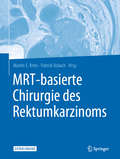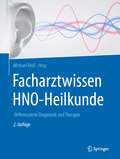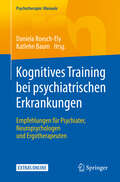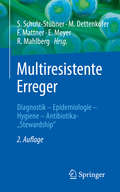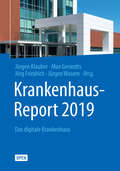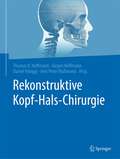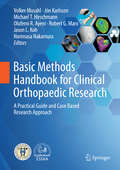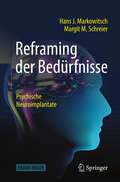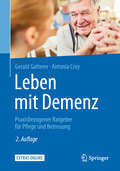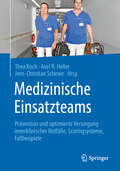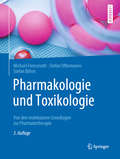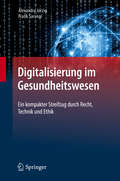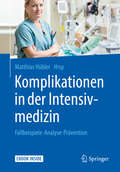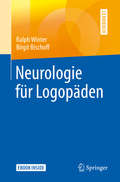- Table View
- List View
Gesundheitsförderung und Prävention für Menschen mit Demenz: Grundlagen und Interventionen
by Doris Gebhard Eva MirWelche Gesundheitsressourcen haben Menschen mit Demenz und wie können diese gezielt gefördert werden? Dieses Buch bietet erstmalig einen multiprofessionellen Einblick in die Beantwortung dieser Fragestellung. Experten aus dem deutschsprachigen Raum präsentieren und diskutieren neben zielgruppenspezifischen theoretischen Grundlagen die aktuelle Interventionslandschaft. Dabei wird eindrucksvoll aufgezeigt, wie beispielsweise Bewegung, Sexualität oder Humor zur Aktivierung von Gesundheitspotentialen beitragen können. Das Buch bietet neben praktischen Beispielen auch eine kritische Auseinandersetzung mit der Evidenzlage und Methoden der Evaluation von gesundheitsfördernden und präventiven Maßnahmen für Menschen mit Demenz. Darüber hinaus werden Handlungsempfehlungen für Wissenschaft und Praxis formuliert, die dazu ermutigen und befähigen, mehr Gesundheit, Freude und Lebensqualität in die Alltagswelt von Menschen mit Demenz zu bringen. Das Buch richtet sich an Pflegepersonen, Altenbetreuer, Praktiker aus dem Bereich der Gesundheitsförderung, Ärzte, Psychologen, Ergotherapeuten, Physiotherapeuten und andere Gesundheitsberufe sowie Angehörige.
Sport und Schlaf: Angewandte Schlafforschung für die Sportwissenschaft
by Daniel ErlacherSport und Schlaf scheinen auf den ersten Blick zwei Themen, die unterschiedlicher kaum sein können: Körperliche sowie mentale Höchstleistungen auf der einen Seite – Inaktivität und Bewusstlosigkeit auf der anderen. Dieses Buch widmet sich diesem neuen Sachverhalt und zeigt anhand unterschiedlicher Beispiele aus der Sportpraxis, dass es hier zahlreiche Anknüpfungspunkte gibt. Ein theoretischer Teil führt zu Beginn in die Grundlagen der Sportwissenschaft und Schlafforschung ein, der weitaus größere Teil widmet sich der Anwendung im sportlichen Umfeld. Unter anderem wird das Schlafverhalten von Athletinnen und Athleten vorgestellt, wie sich Jet Lag im Sport und Schlafdeprivation vor sportlichen Leistungen als auch vor Wettkämpfen bemerkbar machen kann. Ebenso werden das Traumerleben von motorischen Handlungen sowie das Training im Klartraum behandelt. Das Buch richtet sich an Interessierte aus der Sportwissenschaft, Schlafmedizin, Psychologie, Neurologie, aber auch an Trainer und Trainerinnen, sowie an sporttreibenden Personen, die sich hier fundierter einlesen möchten.
Allergieprävention: Moderne Strategien der Allergieforschung im Dialog mit der TCM
by Karin StockertIn naher Zukunft wird die Hälfte der Menschheit an Allergien leiden. Dieses Buch präsentiert präventive Strategien unter Berücksichtigung aktueller Mikrobiom-Forschung und der bisher noch wenig diskutierten Rolle der Lipidmediatoren. Diese beiden Wunderwerke der Evolution werden durch die weltweit reduzierte Biodiversität und veränderte Lebensbedingungen sowie durch frühe und häufige Gabe von Antibiotika und nichtsteroidalen Antirheumatika (NSAR) dauerhaft gestört.Rezidivierende „banale“ Infekte können bei Prädisponierten die Sensibilisierung erleichtern und bei Allergikern zu akuten Exazerbationen mit Etagenwechsel und Fortschreiten des „allergischen Marsches“ führen. Daher spannt die Autorin einen Bogen über 2000 Jahre - zwischen aktuellster Grundlagenforschung des 21. Jahrhunderts und der Weisheit des Klassikers der TCM "Shānghán zábìng lùn". Sie bringt dabei zum Vorschein, dass die heutige Allergieforschung die Stärkung der Selbstheilungsmechanismen ebenso fokussiert, wie es die klassische chinesische Medizin seit jeher tut. Dieses Buch will zu vernetztem Denken motivieren und zu gemeinsamer Forschung anregen, um genau jene Lücke bei der Behandlung des akuten Infekts zu schließen, für die die heutige Allergieforschung so dringend eine wirksame Therapiemöglichkeit sucht.
MRT-basierte Chirurgie des Rektumkarzinoms
by Martin E. Kreis Patrick AsbachIn systematischer Form und mit umfangreichem Bildmaterial führt dieses Buch in die Anwendung der MRT-Bildgebung in der Behandlung des Rektumkarzinoms ein. Chirurgen und Radiologen finden Antworten auf ihre wechselseitigen Fragen: Welche therapeutischen Schlüsse lassen sich aus den MRT-Befunden ableiten? Welche Informationen benötigen die Chirurgen bei der Planung des operativen Eingriffs? Welche Fragen kann der MRT-Befund beantworten und welche nicht? Die enge Kooperation beginnt beim Staging und reicht bis zur Therapieplanung beim Rezidiv des Rektumkarzinoms. Der konsequente Einsatz der MRT-Bildgebung erleichtert die differenzierte, auf den Patienten zugeschnittene Therapiewahl und wird das therapeutische Vorgehen beim Primär- und Rezidiveingriff revolutionieren.
Starke Stimme - Stark im Job: Ihr Trainingsprogramm für mehr Überzeugungskraft im Beruf
by Wiltrud Föcking Marco ParrinoPräsentieren, überzeugen, sich behaupten – die Stimme ist im beruflichen Alltag essentieller Begleiter und Erfolgsfaktor. Sie sprüht vor Freude, bebt vor Ärger, zittert vor Unsicherheit oder durchdringt einen Raum mit Überzeugungskraft. Eine starke Stimme gibt Ihnen das Gefühl, etwas bewegen zu können. Erlangen Sie mit dem innovativen 3+1©-Konzept mehr Überzeugungskraft! In diesem Buch finden Sie u.a. Grundlagen zu Funktionsweise und Wirkung der Stimme, zum Einfluss der Umgebung auf die Stimme und zahlreiche spannende Übungen zur gezielten Stärkung der Stimme für den Job.„Wiltrud Föcking und Marco Parrino haben mir mit ihren Übungen geholfen, als ich vor lauter Bühnenshows heiser war. Die Autoren sind beseelt von ihrem Fach. Ich wünsche diesem Buch viel Erfolg, damit jeder weiß, wie er seine Stimme erheben kann, ohne sie zu verlieren. Darauf ein Oh-Ah-Oh!“Dr. E. v. Hirschhausen„Den Autoren Föcking und Parrino ist in exzellenter Weise gelungen, die Grundlagen mit vielen praktischen Übungen zu vereinen. Entstanden ist ein moderner und praxistauglicher Ratgeber für jeden, der effektiv an seiner Stimme arbeiten möchte."Dr. med. J.-H. Lemke
Facharztwissen HNO-Heilkunde: Differenzierte Diagnostik und Therapie
by Michael ReißUnter dem Druck zunehmender Arbeitsverdichtung wird die Ressource Zeit für Ärzte immer knapper. Das Buch ist so gestaltet, dass eine zeitsparende Informationsaufnahme möglich ist – ohne dabei auf die notwendige Tiefe zu verzichten. Im Mittelpunkt stehen detaillierte und differenzierte Empfehlungen zu Diagnostik und Therapie in der HNO-Heilkunde. Tabellen, Algorithmen und schematische Übersichten liefern einen schnellen Überblick. Das Buch dient der effizienten Prüfungsvorbereitung oder als Nachschlagewerk während der täglichen Routine.
Kognitives Training bei psychiatrischen Erkrankungen: Empfehlungen für Psychiater, Neuropsychologen und Ergotherapeuten (Psychotherapie: Manuale)
by Daniela Roesch-Ely Katlehn BaumZahlreiche psychiatrische Erkrankungen gehen mit kognitiven Störungen einher, die die Alltagsfunktionalität der Patienten teils erheblich einschränken. In diesem Buch geben die Herausgeberinnen einen Überblick über kognitive Störungen bei ausgewählten Erkrankungen wie Schizophrenie, affektiven Erkrankungen, adultem ADHS und Autismus-Spektrum-Störungen und präsentieren praxisnahe Empfehlungen zu Planung, Struktur und praktischer Umsetzung entsprechender kognitiver Trainingsprogramme. Abgerundet wird das Manual durch entsprechende Fallbeispiele sowie verschiedene Informations- und Arbeitsblätter, die zum Download zur Verfügung stehen.Dieses Manual entstand in der Psychiatrischen Ambulanz für Kognitives Training (PAKT) des Universitätsklinikums Heidelberg und richtet sich an Psychiater, Neuropsychologen und Ergotherapeuten, die Patienten mit psychiatrischen Erkrankungen und assoziierten kognitiven Defiziten behandeln.
Multiresistente Erreger: Diagnostik - Epidemiologie - Hygiene - Antibiotika-„Stewardship"
by Rolf Mahlberg Sebastian Schulz-Stübner Markus Dettenkofer Frauke Mattner Elisabeth MeyerIn dem vorliegenden Werk beschreiben ausgewiesene Experten, welche diagnostischen und allgemeinen therapeutischen Maßnahmen bei Infektionen mit multiresistenten Erregern sinnvoll und erfolgsversprechend sind. Das Werk wendet sich an alle Ärzte in allen Einrichtungen des Gesundheitswesen, die Patienten mit Infektionen durch multiresistente Erreger betreuen. Es beschreibt darüber hinaus die Mechanismen der Resistenzentwicklung gegen Antibiotika und wie sich diese vermeiden lassen – im Krankenhaus, in der Arztpraxis und in der Veterinärmedizin. Auch auf die psychologischen Aspekte im Umgang mit Patienten, Angehörigen, medizinischem Personal und der Öffentlichkeit bei Infektionen durch MRE gehen die Autoren ein. Die 2. Auflage erscheint komplett aktualisiert mit Ausblicken auf zukünftige Entwicklungen. Aus dem InhaltGeschichtliche Entwicklung und Public Health-Aspekte von Infektionen mit multiresistenten ErregernArt der Resistenz, Diagnostik, Screening, Epidemiologie, krankenhaushygienische Maßnahmen und Therapie von multiresistenten Staphylococcus aureus (MRSA), multiresistenten gramnegativen Erregern (MRGN), Vancomycin resistenten Enterokokken (VRE) und „multidrug resistent tuberculosis“ (MDR-TB)Primärprävention der Resistenzentwicklung gegen AntibiotikaPsychologische Aspekte im Umgang mit MRE aus Sicht von Patienten, Angehörigen, des medizinischen Personals und der Öffentlichkeit
Die Geburt des Bewusstseins: Über die Entwicklung des frühkindlichen Gehirns
by Hugo LagercrantzDieses Sachbuch gibt verständlich, fesselnd und lebendig Einblick in die Besonderheiten der frühkindlichen Entwicklung und die Folgen von Störungen und Fehlentwicklungen des Gehirns während unterschiedlicher Phasen: vor, während und nach der Geburt. Der schwedische Kinderarzt Hugo Lagercrantz liefert populärwissenschaftliche Erläuterungen zur frühkindlichen Hirnentwicklung und kombiniert sie mit klinischen Aspekten. Er zeigt, wie sich das kindliche Gehirn im Neugeborenen– und Säuglingsalter entwickelt und erklärt daraus die Entstehung bestimmter Erkrankungen. Lagercrantz beschreibt spannende neue Erkenntnisse über Schmerzen und Stress beim Ungeborenen und klärt über das Bewusstsein des Neugeborenen auf. Für alle, die sich professionell oder aus privatem Interesse mit dem kindlichen Hirn beschäftigen wollen.
Krankenhaus-Report 2019: Das digitale Krankenhaus
by Jörg Friedrich Jürgen Wasem Jürgen Klauber Max GeraedtsDer Krankenhaus-Report erscheint jährlich als Open Access-Buch und als gedrucktes Buch. Er nimmt relevante, vorwiegend ordnungspolitische Themen im Kontext Qualität und Wirtschaftlichkeit der Krankenhausversorgung in den Fokus, behandelt jeweils ein Thema schwerpunktmäßig und enthält einen umfassenden Datenteil. Schwerpunkt des Krankenhaus-Reports 2019 ist "Das digitale Krankenhaus".
Trainingswissenschaft für die Sportpraxis: Lehrbuch für Studium, Ausbildung und Unterricht im Sport
by Alexander FerrautiDieses motivierende und reichhaltig illustrierte Lehrbuch wendet sich an Studierende im Fach Sportwissenschaft sowie an Trainer, Auszubildende und Schüler in sport- und fitnessbezogenen Berufen und dient diesen als ideale Prüfungsvorbereitung. Es ist besonders geeignet als Begleit- und Vertiefungslektüre für Vorlesungen im Fach Trainingswissenschaft.Trainingswissenschaftliche Themen werden anschaulich, gut verständlich und praxisrelevant dargestellt. Auch interessierte Leistungs- und Freizeitsportlerinnen und -sportler erhalten eine ausgewogene Mischung von evidenzbasierten sportwissenschaftlichen Erkenntnissen und praktischen Trainingstipps.Wertvolle Hinweise zu den Bereichen Leistungsdiagnostik, Trainingssteuerung, Monitoring und Wettkampfanalyse bilden das Rückgrat des Buches. Das Grundlagenwissen zum Kraft-, Schnelligkeits-, Beweglichkeits-, Ausdauer- und Techniktraining wird durch angemessene biologische Vertiefungen und durch Exkurse zu modernen Trainingsinterventionen erweitert. Dem klaren Plädoyer für Individualisierung und Sportartspezifität des Trainings wurde durch gesonderte Kapitel zu ausgewählten Sportarten Rechnung getragen. Neben dem Leistungssport, stehen auch die Besonderheiten des Trainings mit Kindern und Jugendlichen, mit Aktiven im mittleren Lebensalter oder mit älteren Masterathletinnen und -athleten im Fokus. Das Buch wagt den Spagat zwischen einer international ausgerichteten forschungsorientierten Trainingswissenschaft und der unweigerlich damit verknüpften Sportpraxis. Abgerundet wird das didaktische Konzept durch interaktives Zusatzmaterial in Form von Videobeispielen, die einfach mit der Springer Nature More Media App abgerufen werden können.
Basiswissen Physik, Chemie und Biochemie: Vom Atom bis zur Atmung – für Biologen, Mediziner, Pharmazeuten und Agrarwissenschaftler (Bachelor Ser.)
by Bruno P. Kremer Horst Bannwarth Andreas SchulzDieses Buch bietet im kompakten Überblick das gesamte Basiswissen der Physik, Chemie und Biochemie in leicht verständlichen Texten und Abbildungen, bei Beschränkung auf das wirklich Notwendige. Es ist abgestimmt auf die Gegenstandskataloge für den ersten Abschnitt der Ärztlichen und der Pharmazeutischen Prüfung. Für Studierende der Biologie, der Ernährungs- und Umweltwissenschaften dient es zur leichteren Orientierung im Grundstudium und zur optimalen Vorbereitung für die Vor- oder Zwischenprüfung. Für diese Neuauflage haben die Autoren alle Kapitel durchgängig aktualisiert.
Rekonstruktive Kopf-Hals-Chirurgie
by Daniel Hänggi Jürgen Hoffmann Thomas K. Hoffmann Jens Peter KlußmannDas vorliegende Fachbuch beschreibt umfassend die multidisziplinäre Versorgung komplexer Defekte im Kopf-Hals-Bereich. Autoren verschiedener, in der Kopf-Halschirurgie tätiger Fachdisziplinen zeigen klinische Problemstellungen und ihre chirurgischen Lösungen aus unterschiedlichen Blickwinkeln auf. Die infrage kommenden Lappenplastiken werden detailliert beschrieben und interdisziplinär dargestellt.Eine Vielzahl von intra- und perioperativen Fotos, sowie systematischen Zeichnungen tragen zur besseren Visualisierung der Vorgehensweisen bei.
Basic Methods Handbook for Clinical Orthopaedic Research: A Practical Guide And Case Based Research Approach
by Robert G. Marx Norimasa Nakamura Michael T. Hirschmann Olufemi R. Ayeni Jón Karlsson Volker Musahl Jason L. KohThis book is designed to meet the needs of both novice and senior researchers in Orthopaedics by providing the essential, clinically relevant knowledge on research methodology that is sometimes overlooked during training. Readers will find a wealth of easy-to-understand information on all relevant aspects, from protocol design, the fundamentals of statistics, and the use of computer-based tools through to the performance of clinical studies with different levels of evidence, multicenter studies, systematic reviews, meta-analyses, and economic health care studies. A key feature is a series of typical case examples that will facilitate use of the volume as a handbook for most common research approaches and study types. Younger researchers will also appreciate the guidance on preparation of abstracts, poster and paper presentations, grant applications, and publications. The authors are internationally renowned orthopaedic surgeons with extensive research experience and the book is published in collaboration with ISAKOS.
Reframing der Bedürfnisse: Psychische Neuroimplantate
by Hans J. Markowitsch Margit M. SchreierDieses Buch richtet sich mit einem neuartigen Ansatz zur Persönlichkeitsentwicklung auf der Basis der Hirnforschung an den interessierten Laien. Dargestellt wird, wie psychische Gesundheit auf neurowissenschaftlichen Grundregeln aufgebaut ist, und wie sie über eine neuartige Vorgehensweise am Beispiel der psychischen Neuroimplantate® stabilisiert und gestärkt werden kann. Die Auswirkung positiver Gefühlswelten auf das Gehirn und auf die psychische Konsistenz werdendem Leser in Form von Szenarien verdeutlicht. Dabei wird gezeigt, wie sich diese auf die Verbesserung des Lebens auswirken. Die Autoren heben darauf ab, dass die individuelle Lebensweise langfristige körperliche, umweltinduzierte Veränderungen – die sogar generationenübergreifend wirksam sein können – nach sich zieht.Die zentrale Botschaft des Buches besteht in einer Anleitung zur Bewusstmachung von Bedürfnissen, wie z.B. Emotionen, Gesundheit, materieller Wohlstand und im Aufzeigen von Möglichkeiten, diese im Rahmen der Anwendung von psychischen Neuroimplantaten für sich nutzbar zu machen.
Leben mit Demenz: Praxisbezogener Ratgeber für Pflege und Betreuung
by Gerald Gatterer Antonia CroyDie demographische Entwicklung prophezeit uns: Wir werden alle älter. Die hinzugewonnene Lebenszeit kann aber oft ein Leben mit Krankheit, Behinderung und der Pflegeabhängigkeit von anderen Menschen sein. Das Buch zeigt das Leben mit einer dementiellen Erkrankung und dient als praxisorientierter Leitfaden für das Zusammenleben mit von Demenz betroffenen Personen. Klar und verständlich werden die Ursachen der Erkrankung sowie Möglichkeiten für Diagnostik und Therapie besprochen. Fachleute aus den Bereichen Medizin, Pflege, Psychologie und Angehörigenbetreuung geben praxisrelevante Lösungen, für die im Verlauf der Erkrankung auftretenden Probleme, vom Erkennen der ersten Symptome bis hin zum Abschiednehmen. Die zweite Auflage wurde komplett aktualisiert und überarbeitet, ergänzt wurden Kapitel zur Demenz aus der Sicht der Betroffenen sowie zur Sexualität im Alter. Professionelle Helfer der Altenpflege sowie Betroffene und deren Angehörige erhalten einen detaillierten Überblick zur Betreuung und Versorgung von dementiell erkrankten Menschen.
Kinderwunsch - Wie Physiotherapie helfen kann
by Anne Marie JensenOb zur Vorbereitung einer Fertilitätsbehandlung, in Ergänzung zu einer begonnenen Therapie oder als Alternative zu schulmedizinischen Behandlungen – dieser Ratgeber informiert Frauen und Paare mit unerfülltem Kinderwunsch darüber, wie physiotherapeutische Maßnahmen auf dem Weg zum Wunschkind helfen können. Die vorgestellten Methoden und Eigenübungen eröffnen in jeder Phase der Kinderwunsch-Behandlung schonende und kostengünstige ergänzende Möglichkeiten, um die Chancen auf eine Schwangerschaft zu erhöhen. Die Autorin nimmt Sie mit auf eine Reise über mehrere Kontinente und zeigt, wie Physiotherapie in Europa, Japan und den USA seit den 1970er Jahren als unterstützende Methode bei Fertilitätseinschränkungen angewendet wurde und wird. Nutzen Sie die vielfältigen Möglichkeiten, die die Physiotherapie Ihnen bietet!
Medizinische Einsatzteams: Prävention und optimierte Versorgung innerklinischer Notfälle, Scoringsysteme, Fallbeispiele
by Thea Koch Axel R. Heller Jens-Christian ScheweDas erste deutschsprachige Werk zum Thema liefert praxisbezogenes Expertenwissen rund um die Implementierung und Bedeutung von medizinischen Einsatzteams in Krankenhäusern. Es wendet sich an Ärzte und Pflegekräfte aller Fachdisziplinen mit besonderem Bezug zum innerklinischen Notfallmanagement ebenso wie an Krankenhausleitungen. Dargestellt werden Ziele und Möglichkeiten von Medizinischen Einsatzteams sowie strukturelle und personelle Voraussetzungen, wie Schulung des Personals und Teams, juristische Aspekte, Kommunikation, und Ethik am Lebensende. Besonders praxisrelevant: Fallbeispiele häufiger Notfallsituationen, systematisch dargestellt nach Symptome, Alarmierungsgrund, Eintreffen des MET, Diagnostik, Maßnahmen, Verlauf, Outcome sowie Besonderheiten und Auswertung.
Motorische Entwicklung und Steuerung: Eine Einführung für Physiotherapeuten, Ergotherapeuten und Trainer
by Paul GeraedtsDie Faszination der menschlichen Motorik wird in diesem Fachbuch verständlich und anschaulich dargestellt. Zahlreiche Praxisbeispiele verdeutlichen Physio- und Ergotherapeuten, Sportwissenschaftlern und Trainern entscheidende Eckpfeiler der einzelnen Entwicklungsschritte von der Kindheit bis ins Erwachsenenalter. Die direkten Auswirkungen unbewusster Steuerungs-, Automatisierungs- und Lernprozesse auf unser Leben werden präzise beleuchtet und entschlüsselt.Der Inhalt: Neurophysiologische Abläufe von automatisierten und Willkürbewegungen - Aus unserem Alltag: Okulo-, Grapho- und Sprachmotorik - Verborgene Potenziale in Training und TherapieVerhelfen Sie Ihrem Patienten in Rehabilitation und Therapie zum bestmöglichen Ergebnis. Nur mit diesen Grundlagen können Sie Athleten im Breiten- und Leistungssport optimal fördern und zum gewünschten Erfolg führen.
Untersuchen und Befunden in der Physiotherapie: Untersuchungstechniken und Diagnoseinstrumente (Physiotherapie Basics)
by Kay BartrowDieses praxisorientierte Lehrbuch vermittelt Schülern und Studierenden der Physiotherapie und Berufseinsteigern das essentielle Handwerkszeug für die physiotherapeutische Untersuchung als Grundlage für eine erfolgversprechende Therapie. Praktisches Vorgehen, Untersuchungs- und Testverfahren, Befundinterpretation, Dokumentation, sowie kompaktes Hintergrundwissen werden strukturiert und verständlich erläutert. Für jeden Untersuchungsschritt wird das Vorgehen anhand ausführlicher Patientenbeispiele und mit zahlreichen Abbildungen veranschaulicht. Plus: Zusatzmaterialien zum Download Neu in der 3. Auflage: typische Fallbeispiele zur Veranschaulichung des Clinical Reasoning Prozesses, erweiterte Hinweise zur Dokumentation von Befundergebnissen, zusätzliche Informationen zum Flaggensystem in der Physiotherapie Für Ausbildung, Studium, Berufsstart und für erfahrene Therapeuten, die ihr Praxiswissen auffrischen wollen.
Pharmakologie und Toxikologie: Von den molekularen Grundlagen zur Pharmakotherapie (Springer-lehrbuch Ser.)
by Stefan Offermanns Michael Freissmuth Stefan BöhmIn diesem Buch werden alle wichtigen Arzneimittel, gegliedert nach Organsystemen, umfassend dargestellt. Dabei wird in jedem Kapitel neben Wirkmechanismus, Kinetik, unerwünschten Wirkungen, Interaktionen und Indikationen auch die Pharmakotherapie beschrieben. Die allgemeinen und die molekularen Grundlagen werden ausführlich erklärt und helfen, Wirkmechanismen besser zu verstehen. Um die große Menge an Lernstoff besser bewältigen zu können, gibt es ein durchdachtes didaktisches Konzept:• Arzneimittel-Steckbriefe für den schnellen Überblick• Lernziele am Kapitelanfang• Fallbeispiele für die Praxis• Cave- und Merksätze für die wichtigsten Fakten
Digitalisierung im Gesundheitswesen: Ein kompakter Streifzug durch Recht, Technik und Ethik
by Alexandra Jorzig Frank SarangiDas Buch sensibilisiert den Praktiker für die rechtlichen Risiken, die die Digitalisierung im Gesundheitswesen mit sich bringt und bietet Lösungsansätze. Datenautobahnen, künstliche (arztersetzende) Behandlungsintelligenz, Pflegerobotor, Health Apps, weltumrundete Onlinesprechstunden in Echtzeit und Blockchain sind als Begriffe in der Medizin nicht mehr wegzudenken. Mit einem Marktvolumen von 58,8 Mrd. US-Dollar im Jahr 2020 stellt die Digitale Revolution auch einen ganz erheblichen Markt mit Chancen für den Gesundheitssektor dar. Digitalisierung soll dem Patienten dienen. Sie soll Prozesse optimieren, effizienter gestalten und hat sich dabei am Datenschutz zu orientieren. Wer haftet für künstliche Intelligenz? Kann künstliche Intelligenz überhaupt versichert werden? Wie lernt künstliche Intelligenz? Und brauchen wir in Zukunft überhaupt noch menschliches Personal? Mit Fallbeispielen und Checklisten bietet das Buch eine Unterstützung für den Praktiker im Alltag.
Komplikationen in der Intensivmedizin: Fallbeispiele-Analyse-Prävention
by Matthias HüblerKomplikationen oder Zwischenfälle sind häufig eine Kombination menschlicher, organisatorischer und technischer Fehler. Das vorliegende Werk zeigt 24 Fallbeispiele aus der Intensivmedizin, bei denen es zu Komplikationen oder Beinahezwischenfällen gekommen ist. Es wendet sich an alle Intensivmediziner, die aus Fehlern lernen oder sich gegenüber Gefahrensituationen sensibilisieren möchten. Jeder Fall gliedert sich in zwei Teile: Darstellung des Geschehens und Analyse der Situation. Dabei werden Einflussfaktoren, wie z.B. Organisation, Kommunikation, Führung, Teamfähigkeit, Ressourcenmanagement für das Zustandekommen des Zwischenfalls eingehend beleuchtet. Und quasi nebenbei - eingewoben in den Fall - lernt der Leser die wichtigsten Fakten des Faches Intensivmedizin.Mit „Komplikationen in der Intensivmedizin“ erscheint nach „Komplikationen in der Anästhesie“ das zweite Werk zum Themenkreis in gewohnt spannender, kurzweiliger und lehrreicher Art und Weise.Praxis-Plus: eBook inside - kostenloser Download des eBooks inklusive
Neurologie für Logopäden
by Ralph Winter Birgit BischoffAphasie, Dysphagie, Dysarthrie - Viele von Logopäden behandelte Störungen beruhen auf neurologischen Erkrankungen. Deren klinische Ausprägungen, Begleitsymptome und Komplikationen zu kennen, ist Voraussetzung für eine erfolgversprechende logopädische Therapie. Mit diesem Lehrbuch lernen Sie, die Symptome neurologischer Krankheiten zu unterscheiden und Ungewöhnliches zu erkennen. Erfahren Sie außerdem, wie Sie in Notfällen rasch und richtig handeln, und informieren Sie sich zum Umgang mit krankheitsbedingten Störungen wie z.B. Aufmerksamkeitsdefiziten, die die logopädische Arbeit erschweren. Für Schüler und Studierende der Logopädie und für praktisch tätige Logopäden.
Gesundheitswissenschaften (Springer Reference Pflege – Therapie – Gesundheit)
by Robin HaringDieses Referenzwerk bietet einen umfangreichen Überblick zu den zentralen Themen der Gesundheitswissenschaften. Die einzelnen Sektionen behandeln sowohl Grundlagen und Methoden der Gesundheitswissenschaften, Elemente der Gesundheitssoziologie und Psychologie (Diversität, Kommunikation, Resilienz), den aktuelle Stand in der Gesundheitssystem- und Versorgungsforschung, als auch die wichtigsten Anwendungsbereiche in Prävention, Gesundheitsökonomie und Gesundheitspolitik. Berücksichtigt werden dabei die Mikroebene der handelnden Akteure, die Mesoebene von Unternehmen und Organisationen, sowie die Makroebene von Gesundheitssystemen, Gesundheitspolitik und Global Health. Das Standardwerk richtet sich an Studierende, Wissenschaftlerinnen und Wissenschaftler unterschiedlicher Disziplinen im Gesundheitsbereich sowie an Expertinnen und Experten aus der Praxis. Dieses Werk gibt den Auftakt zu der neuen Reihe „Springer Reference Pflege – Therapie - Gesundheit“ und setzt neue Maßstäbe in der Fachliteratur der Gesundheitsberufe.



